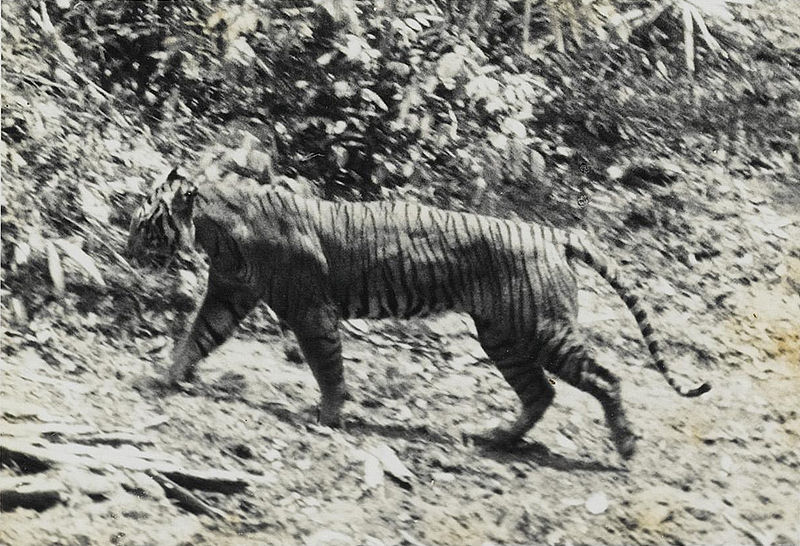Tigers: brutal, delightful, jeopardized. They're probably the most adored large felines on the planet, but on the other hand they're the absolute most extraordinary. Today, less than 5,000 tigers get by in the wild, occupying only 5% of their notable reach. The specific number of tiger species on the planet has for some time been a wellspring of conflict among researchers.
Today, there are two authority types of tiger: the mainland tiger, and the Sunda island tiger. Mainland tigers are those that live (or lived) in central area Asia, while Sunda island tigers are those that live (or lived) on the islands of Indonesia.
Bali Tiger

Bali tigers vanished at some point during the 1950's
The last Bali tiger on the planet kicked the bucket at some point during the 1950s. However, the subspecies wasn't authoritatively proclaimed extinct until 2008. These tigers lived exclusively on the island of Bali, in Indonesia. Males grew up to 7.7 feet long, and gauged as much as 220 pounds. Females grew up to 7 feet in length, and gauged as much as 175 pounds. These smallish tigers surrendered to territory misfortune and overhunting.
Sumatran Tiger

Sumatran tigers live on the island of Sumatra
The main enduring individual from the Sunda island tigers, the Sumatran tiger lives just on the island of Sumatra, in Indonesia. Male Sumatran tigers grow up to 8 feet in length, and gauge as much as 265 pounds. Females grow up to 7 feet in length, and gauge as much as 200 pounds. These tigers go after a few types of deer, wild pig, porcupine, and monkeys, similar to macaques. Sumatran tigers are fundamentally jeopardized; their primary dangers are poaching and environment misfortune because of the palm oil industry.
Javan Tiger

The Javan tiger lived on the Indonesian island of Java until the mid 1970s
This tiger species, endemic just to the island of Java, in Indonesia, became terminated during the 1970s. Male Javan tigers grew up to 8.2 feet long, and gauged as much as 315 pounds, with females becoming marginally more modest. People eliminated Javan tigers through a blend of hunting and territory obliteration. This subspecies was formally proclaimed wiped out in 2008.
South China Tiger

There are under 100 South China tigers staying on the planet
The South China tiger is the littlest of all mainland subspecies. Less than 100 of these tigers stay in the regions of Guangdong, Fujian, Hunan, and Jiangxi, in southern China. Male south China tigers grow up to 8.8 feet long, and gauge as much as 330 pounds. Females grow up to 7.10 feet long, and gauge as much as 240 pounds. In spite of their status as dominant hunters at the head of the pecking order, South China tigers are near the precarious edge of eradication.
Indochinese Tiger

Indochinese tigers are compromised by unlawful poaching
This tiger species lives just in Myanmar, Laos, and Thailand. There are believed to be less than 500 Indochinese tigers left in nature. Guys grow up to 9.4 feet long and gauge as much as 430 pounds. Females grow up to 8.4 feet long, and gauge as much as 285 pounds. The greatest danger to the Indochinese tiger is unlawful poaching, as tiger body parts are sought after for their utilization in conventional Chinese medication.
Malayan Tiger

Malayan tigers are fundamentally jeopardized and there are less than 300 of them left in nature
These fundamentally jeopardized tigers live just on the Malaysian Landmass. There are believed to be less than 300 Malayan tigers left in nature. Somewhat greater than the Indochinese tiger, Malayan tigers grow up to 9.5 feet long, and gauge as much as 260 pounds. Their greatest danger comes from territory misfortune and fracture, generally because of the palm oil industry.
Bengal Tiger

Populaces of Bengal tigers have stablized, in spite of the fact that they are currently in danger from poaching
This tiger species is endemic to Bhutan, Nepal, India, Pakistan, and Bangladesh. Male Bengal tigers grow up to 10 feet in length, and gauge as much as 570 pounds. Females grow up to 8.7 feet long, and gauge as much as 350 pounds. Because of preservation endeavors in the beyond twenty years, Bengal tiger populaces have balanced out in numerous areas. Be that as it may, they are still under danger. Their essential dangers come from poaching for the unlawful natural life exchange, and retributory killings because of human/natural life struggle. The delightful White tigers are a transformation of the Bengal tiger.
Caspian Tiger

Caspian tigers could arrive at 10 feet in length and weighed as much as 530 pounds
When found all through the riverine valleys of Focal Asia and the Center East, this tiger species went wiped out during the 1970s. Caspian tigers surrendered to territory misfortune — they had some expertise in a large number of the very conditions that people see as ideal for farming and residence — and overhunting. Guys grew up to 10 feet in length, and gauged as much as 530 pounds, with females somewhat more modest. Caspian tigers chased deer, mountain sheep, and wild pig.
Siberian (Amur) Tiger

Amur tigers are the biggest enormous felines in this present reality
Siberian tigers once lived all through Eastern Russia and Upper east China. Today, they stay just in the Russian Far East. Guys of this tiger species are the biggest huge felines on the planet; they grow up to 11 feet in length, and gauge as much as 600 pounds. Females grow up to 9 feet in length, and gauge as much as 370 pounds. Like all tigers, Siberian tigers are commit carnivores. This implies they need nothing other than meat in their eating regimen. Prey species incorporate roe deer, moose, musk deer, rabbits, wapiti, and even bear.
The primary danger to the Siberian tiger's endurance is the interest for tiger body parts, similar to furs, bones, teeth, and organs. This request is met through a mix of poaching, and hostage reproducing of tigers in coldhearted tiger ranches.









